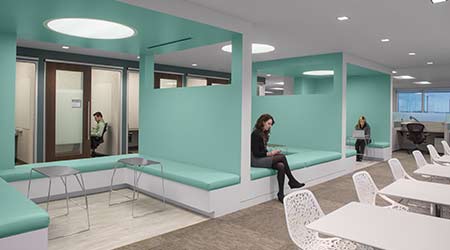 KeyBank’s Tiedeman Operations Facility is home to the company’s technology, operations and call center groups. Forty percent of the technology group practices mobility, and the Tiedeman facility integrates a mobility plan with progressive workplace strategies.Maguire Photo
KeyBank’s Tiedeman Operations Facility is home to the company’s technology, operations and call center groups. Forty percent of the technology group practices mobility, and the Tiedeman facility integrates a mobility plan with progressive workplace strategies.Maguire PhotoWith a Mobile Workforce, Coworking Space Offers Flexibility, Cost Savings
By Scott Ashley and Megan Spinos
Ready or not, the old-style office is fading fast. Now that the structure of work is becoming less tied to a particular time and place, the traditional corporate real estate model of assigning all employees to a fixed space in a single building or on a single campus is rapidly becoming outdated. Instead, for organizations with mobile workforces, coworking offers flexibility, cost savings, and an opportunity to foster innovation.
Coworking environments are communal spaces where mobile workers, freelancers, and other professionals from different organizations come together to work in the same setting.
Even if an organization isn’t ready to abandon all its traditional spaces and fully embrace a complete coworking model, taking inspiration from this concept can lead to new, more impactful ways of working for employees and drive a more efficient use of corporate real estate.
What does a coworking model look like?
Traditional corporations are used to a one-to-one ratio of seats to employees, with a highly resident employee base, while more progressive organizations may have embraced the concept of mobile work. Coworking pushes the boundaries of design one step further, with a ratio that’s more like one-to-thirty.
Rather than occupying multiple floors within an existing building, or designing large campus installations, companies can reduce their real estate footprint by creating spaces filled with “just in time” seats, free to be used by whoever needs them at that particular date and time. An increasing number of workers are choosing to work remotely by scheduling their work in the way that allows them to optimize their productivity, and coworking spaces allow for this flexibility, while also decreasing real estate costs for employers.
Organizations may choose to create areas for coworking within their owned spaces, or can provide employees with memberships to coworking locations like WeWork. Some corporations even join together to create coworking spaces where all of their employees can mix, creating the ideal opportunity for “casual collisions” that lead to new ideas. Since coworkers come from varying backgrounds and organizations, bringing them together in one space offers the opportunity to generate new ideas informed by a wide range of experiences, which may lead to a more fruitful result.
What are the benefits for an organization?
Studies have shown that at any given time a substantial fraction of workspace in a typical corporate office setting is empty — meaning that organizations are paying for space they don’t really need. Much of this underutilization of space is indicative of workers’ inherent mobility — going to and from meetings throughout the office, or working or attending meetings elsewhere.
As a result, companies may choose coworking because it can lower their real estate costs and provide greater flexibility in procuring space. On the whole, creating spaces for coworking, or purchasing memberships for coworking spaces for employees, tends to be more affordable than opening dedicated office spaces in markets with a large percentage of highly mobile workers.
Not only does a coworking model provide the opportunity to condense real estate and save costs, it also has benefits for employee engagement. Letting talent lead the way in terms of where and how they want to work boosts satisfaction and keeps them excited about their work. Just as many companies choose their office locations based on where their clients are, so too should employers begin to create spaces for work where their employees want to be.
Flexible coworking plans allow for people to use these unconventional spaces in ways that fit their schedule, whether that’s a typical nine-to-five day or just a few hours per week. Many who use coworking spaces don’t work from them every day, even when they have a full-time spot, according to a study conducted by MIT Sloan. Survey respondents said they spend 56 percent of their time working from a coworking space over a typical two-week period. They report spending 29 percent of their time working from home and the balance of their time working from alternative spaces such as coffee shops, libraries, and even traditional offices. Those results suggest that organizations don’t need a vast amount of space to fulfill employee needs — agile, accessible spaces are more important than a permanent spot for each worker.
Coworking also creates connections. It’s difficult to drive new ideas through an organization with a real estate layout that leads to silos and inhibits knowledge-sharing and collaboration. Coworking spaces bring together employees of different disciplines and encourage them to engage, fostering the development of new thought and innovation — a critical process for any organization’s future growth and success.
When does coworking work best?
To be productive, coworking spaces need to have the right amenities. Technology is essential. From Wi-Fi access to printers, employees must be able to access what they need, when they need it. A mix of seating and space types — desks, lounges; private vs. open — is necessary for the space to support an array of tasks. Highly flexible furniture is also key, so layouts can be adjusted as needed.
However, it’s important to keep in mind that coworking isn’t for everyone. More traditional organizations may find it challenging to make the jump from a more structured space to an open, flexible environment, but those companies that already have collaboration woven into the fabric of their culture may find coworking to be an extremely impactful solution. If an organization already is in an open plan, with a highly mobile work force, and has a desire to keep engagement high and condense real estate, this concept might be worth applying.
Whether or not organizations are ready to abandon their traditional office spaces, the coworking model provides insights that can be implemented in any office environment. Simply put, the best spaces are those that support employees’ needs, create opportunities and inspire meaningful work.
Megan Spinos is the director of workplace strategy for Vocon, one of the largest architecture and design firms in the United States, as well as one of the top 40 firms internationally. Connect with her on Twitter @MeganSpinos. Scott Ashley is the senior workplace strategist for Vocon. Connect with him on Twitter @scottdashley.
Related Topics:












